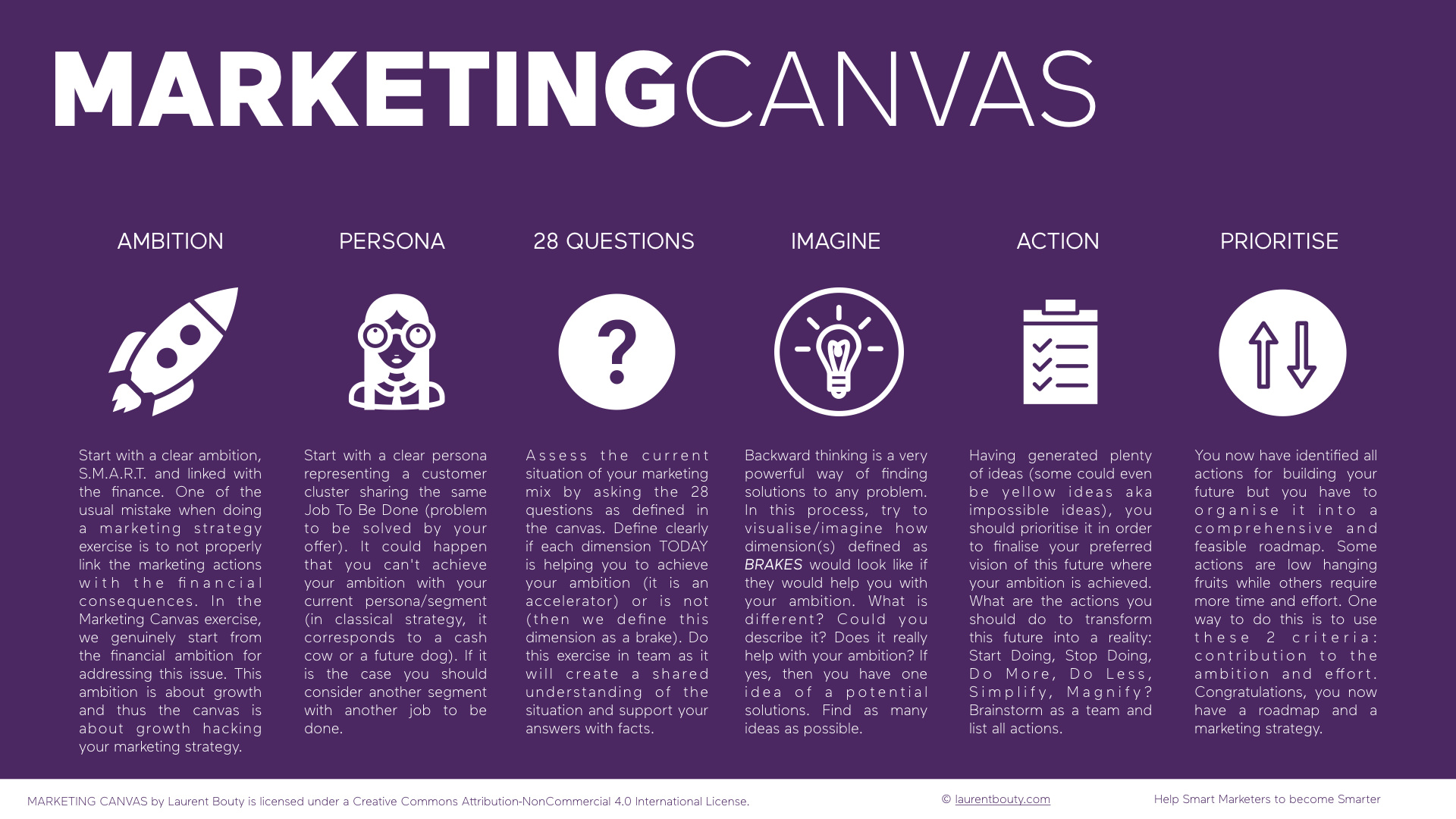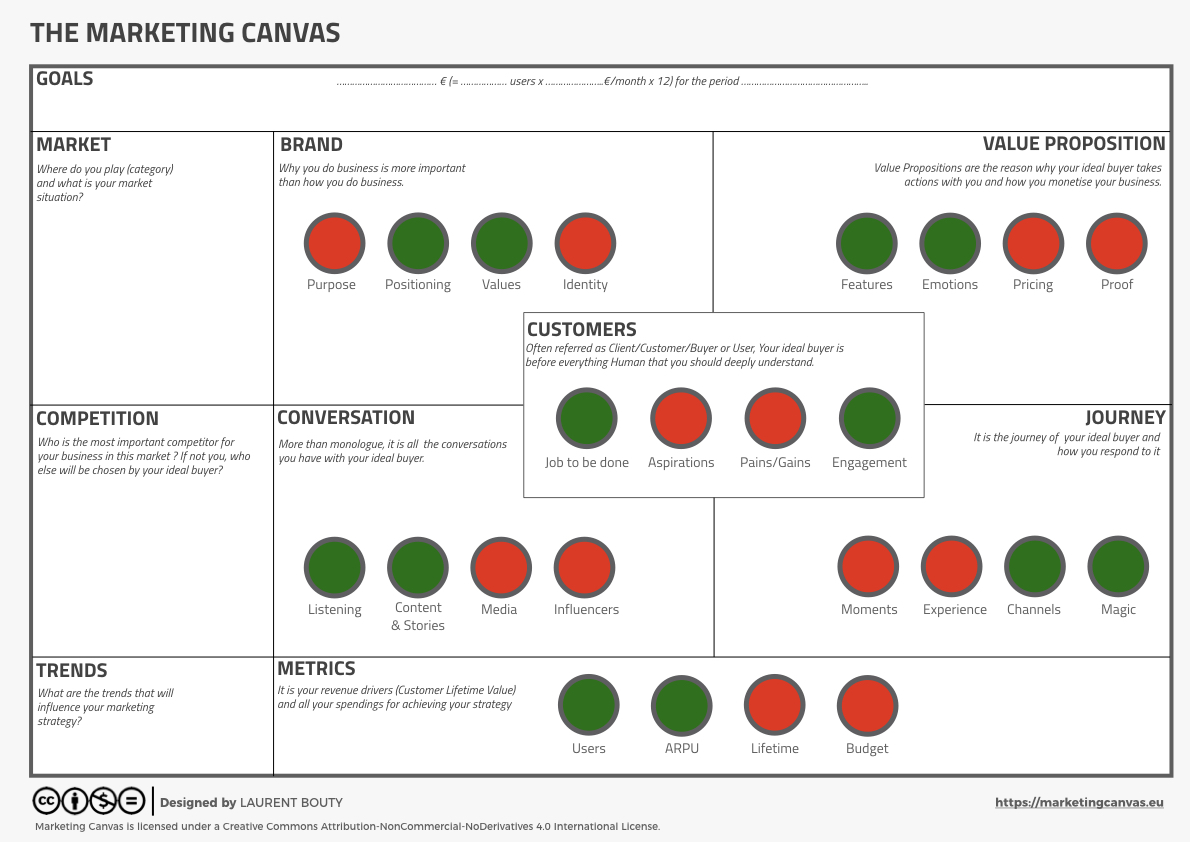In the Marketing Canvas Process, after having finalised your assessment, you should discuss potential scenarios that will help you achieve your goal(s). An interesting perspective for this phase is to use the scenarios proposed by Tiffani Boffa in her book Growth IQ.
Marketing Canvas - Listening to
In today's digitally connected world, the importance of listening to customers has never been more paramount. This comprehensive guide dives deep into the process of establishing an effective Voice of Customer (VoC) system. It lays the groundwork for understanding why listening is crucial, how to listen effectively, and how to translate customer feedback into actionable insights. The guide also offers tips for choosing the right tools for the task, provides a step-by-step assessment for evaluating your listening methods, and even includes a real-world case study to demonstrate these principles in action. In a world where customer satisfaction drives business success, this guide will arm you with the knowledge you need to ensure that your customers always feel heard.
Marketing Canvas - Magic
In our ever-evolving digital landscape, creating a memorable and unique customer experience is paramount. This article delves into the realm of 'Magic' in marketing, a concept that encourages the creation of extraordinary events throughout the customer journey. Drawing inspiration from industry-leading tools, we discuss how to inject Magic into every customer interaction. We further illuminate the role of sensory engagement and personalization, breaking down their importance in nurturing a remarkable customer journey. Unpack the significance of 'Moments of Truth', those crucial points that shape a customer's relationship with your brand. Furthermore, we explore effective evaluation techniques to ensure your strategies truly work their magic. Incorporating examples, actionable tips, and deep-dives into each concept, this article seeks to empower businesses to create enchanting customer experiences that drive loyalty and growth.
Marketing Canvas - Channels
In a world dominated by digital and physical touchpoints, the understanding and orchestration of Channels form a crucial part of any marketing strategy. This comprehensive guide explores Channels in marketing as a sub-dimension of the Marketing Canvas by Laurent Bouty. It delves into the roles channels play in customer interactions, highlights key considerations such as interaction, information, and context, and provides practical tips on choosing the right tools.
The guide further translates these insights into action steps and underscores the significance of continuous evaluation and improvement for optimal channel performance. A detailed look into a use case example of 'Green Clean' elucidates these concepts with real-world relevance. Finally, the guide helps you assess your own marketing strategies with detailed explanations for varying scores in the evaluation process and proposes recommendations for enhancement. This guide serves as an invaluable resource for marketers, entrepreneurs, and non-marketers alike to navigate the complex terrain of channels in marketing.
Marketing Canvas - Experience
Navigating the complex landscape of customer experience can be a challenging task for brands. This article provides an in-depth understanding of 'Moments'— a crucial sub-dimension in the customer journey aspect of the Marketing Canvas, a strategic tool developed by Laurent Bouty. The piece highlights the importance of consciously orchestrating these moments and how they shape customers' perception of your brand. Using insights from Matt Watkinson's 'The Ten Principles Behind Great Customer Experiences,' the article outlines a structured approach to managing these interactions effectively. It also presents practical tools, evaluation methods, and improvement strategies to enhance these moments. With the aid of a case study on Green Clean, the reader will grasp the tangible application of these principles. This article is an invaluable resource for marketers, entrepreneurs, and anyone seeking to optimize their marketing strategy and create memorable customer experiences.
Marketing Canvas - Moments
This article offers an in-depth exploration of 'Moments' in the marketing journey - crucial touchpoints that define customers' interactions with your business. From discovering your product to post-purchase stages, these Moments shape customer perception and engagement. We delve into how to identify and understand these Moments, employing strategies like Google's SEE-THINK-DO-CARE framework. The piece also covers evaluation methods for your Moments strategy, offering a scoring system that helps businesses pinpoint areas of improvement. Through a real-world example, it illustrates how this concept can be applied practically, fostering effective, empathetic marketing strategies. This article is a must-read for marketers, entrepreneurs, and anyone eager to enhance their customer experience and overall business success.
Marketing Canvas - Proofs
In this comprehensive guide, we explore the concept of "proofs" in marketing - the crucial elements that make your value proposition compelling and credible. We delve into various types of proofs such as studies, expert recognition, social proof, and certifications, demonstrating how each contributes to a solid marketing strategy. To illustrate this concept, we look at a real-world example of a company that successfully utilized proofs. The guide also includes a unique framework for evaluating and improving your proofs, helping you fine-tune your marketing strategy. Whether you're a seasoned marketer or an entrepreneur starting your marketing journey, this guide provides practical insights that can enhance your marketing effectiveness.
Marketing Canvas - Pricing
Marketing Canvas - Emotions
Today, differentiation comes through emotions and not functional features. Especially, if you look at it from the Experience Economy (from Gilmore and Pine) [1]. Do you know if you deliver the right emotional features? Can you leverage more the emotional dimensions in your value proposition for creating value? Answering yes means that you can create extra value through the emotional dimension of your value proposition
Marketing Canvas - Features
Unlock the full potential of your product or service with compelling features. This comprehensive guide explores the importance of features in your value proposition, how they can make you stand out, and effective tools to enhance them. Create a unique selling proposition that resonates with customers.
Marketing Canvas - Visual Identity
Our article delves into the integral role of Visual Identity, a critical sub-dimension of the Marketing Canvas developed by Laurent Bouty. We begin with defining visual identity, as conceived by eminent industry figures like David Aaker and Jeff Bezos, and explain how it goes beyond merely a logo or graphic design. Exploring connections to other sub-dimensions such as Purpose, Positioning, and Values, we highlight its overall impact on your brand's strength. We break down the assessment process into a robust scoring system, identifying potential reasons for various scores and recommending improvement strategies tailored to each scenario. By synthesizing theory with real-world applications, this article offers valuable insights for anyone keen to strengthen their brand's visual identity. Whether you're a seasoned marketer, budding entrepreneur, or simply interested in understanding branding better, our guide aims to make the complex concept of visual identity easy to grasp and apply.
Marketing Canvas - Values
Your values are the translation of your purpose into key behaviors. Most of the commercial activities are delivered through behaviors (from people or from systems). When developing your marketing strategy, you should have Brand values that are fully amplifying your Brand Purpose. It will help your organization to translate your beliefs into action.
Hack: Marketing Canvas and Triple Bottom Line
As Marketers, we are not excused for being complaisant with the world around us. It should have been always the case but today the situation is so critical that we need to take action.
REVISIT STEP 2 - SET YOUR GOAL
The original approach at Step 2 was profit oriented. Indeed, during this step, we recommend to set a financial goal (revenue) before starting step 3 which is the assessment.
The triple bottom line approach (wikipedia) as proposed by John Elkington consists of extending the bottom line concept with sustainable elements. In addition to Profit, Elkington proposed to add Planet and People. The Marketing Canvas Method can be easily hacked for integrating the Triple Bottom Line concept by simply changing the way Goals are set during step 2.
HOW?
At Step 2, you can define goal for Profit (original approach) but also goal for Planet and People. It is not fully clear for me whether a standard framework exists with clear KPIs linking Marketing Strategy and Planet/People elements. You can chose the goals that would specifically work for you when discussing Planet and People topics. Based on a very quick desk research, I identified few topics that could be used for defining objectives for Planet and People. It would be interesting to have your point of views and make this list more robust. Don’t hesitate to comment this post.
LIST OF GOALS FOR PEOPLE AND PLANET
Energy Management: How could you reduce your energy consumption and use more renewable energy when executing your marketing strategy? Goal?
Resource Management: How could you make use of resources for your marketing strategy in such a way that our next generation or in future there are no effects on the resource? Goal?
Waste Management: How could you collect, transport, process or dispose of, manage and monitor various waste materials generated by your marketing strategy? Goal?
Employee Welfare: How could you reinforce employee welfare when executing your marketing strategy? Goal?
Fair Trade: How could you reinforce fairness in your marketing strategy through dialogue, transparency and respect, that seeks greater equity in international trade? Goal?
Cause Marketing: How can you better the society while executing your marketing strategy? Goal?
PROCESS
When you have defined these goals (e.g. CO2), you can apply the Marketing Canvas Method for assessing your current situation (STEP 3). Let’s take 2 examples from the 24 dimensions.:
JOB TO BE DONE (CUSTOMERS): Is the knowledge of your customers’ job to be done helping you from achieving your goals?
FEATURES (VALUE PROPOSITION): Are the features of your value proposition helping you achieve your goals?
By asking these questions, you have interesting discussions about your current ability to achieve these goals (like CO2) or not (Brake or Accelerator).
NEW TEMPLATE
Le Marché dans le Marketing Canvas
Dans l’enthousiasme de travailler sur sa stratégie marketing, on se précipite souvent et oublie l’importance de ce que je considère comme la première étape: la compréhension du marché dans lequel nous allons opérer (startup) ou nous opérons déjà (entreprise existante). Il y a 3 questions importantes à se poser lorsqu’on analyse le marché. C’est questions sont: …
Marketing Canvas - Ambition
Marketing Strategy for Millennials from Marketing Cloud
3 Cs in a Digital World
Interesting article from Roland Berger Consultants about Sales in a Digital World. Their thesis is that you need to master 3 Cs if you want to have a voice in this new world:
- Develop the Customer Base: It is definitely in line with what I am preaching. You should not only focus on acquisition but also on stimulation and retention. The CLV dimension of the Marketing Canvas is telling you how much you perform versus your ambition;
- Orchestrate the Channel: I also agree but I would extend this to Orchestrate the Customer Journey as it is much broader than channel and it is integrating elements like Brand experience, touch-points, emotions and wow moments.
- Manage the complexity: it is maybe fluffy as notion. We all know that we should manage the complexity, the question is how should I do that. One possible answer is in the article when they discussed centralisation. I think the key element there is to automate your processes (BPM, scripting, algorithms, ...) in order to reduce the chaos and uncertainty. but don't forget to keep the human part.
Source: Roland Berger, Think Act, The digital future of B2B sales
Marketing Canvas, some tips about the process
Canvas works really well if:
- Start with a clear ambition, S.M.A.R.T. and linked with the finance. One of the usual mistake when doing a marketing strategy exercise is to not properly link the marketing actions with the financial consequences. In the Marketing Canvas exercise, we genuinely start from the financial ambition for addressing this issue. This ambition is about growth and thus the canvas is about growth hacking your marketing strategy.
- Start with a clear persona representing a customer cluster sharing the same Job To Be Done (problem to be solved by your offer). It could happen that you can't achieve your ambition with your current persona/segment (in classical strategy, it corresponds to a cash cow or a future dog). If it is the case you should consider another segment with another job to be done.
- Assess the current situation of your marketing mix by asking the 28 questions as defined in the canvas. Define clearly if each dimension TODAY is helping you to achieve your ambition (it is an accelerator) or is not (then we define this dimension as a brake). Do this exercise in team as it will create a shared understanding of the situation and support your answers with facts.
- Backward thinking is a very powerful way of finding solutions to any problem. In this process, try to visualise/imagine how dimension(s) defined as BRAKES would look like if they would help you with your ambition. What is different? Could you describe it? Does it really help with your ambition? If yes, then you have one idea of potential solutions. Find as many ideas as possible.
- Having generated plenty of ideas (some could even be yellow ideas aka impossible ideas), you should prioritise it in order to finalise your preferred vision of this future where your ambition is achieved. What are the actions you should do to transform this future into a reality: Start Doing, Stop Doing, Do More, Do Less, Simplify, Magnify? Brainstorm as a team and list all actions.
You now have identified all actions for building your future but you have to organise it into a comprehensive and feasible roadmap. Some actions are low hanging fruits while others require more time and effort. One way to do this is to use these 2 criteria: contribution to the ambition and effort. Congratulations, you now have a roadmap and a marketing strategy.
Why you need a bold question for your Marketing Strategy?
How To Define Your Commercial Plan for Your Startup with Marketing Canvas?
When you work on your commercial strategy for your startup, you can facilitate this conversation with using the Marketing Canvas (more on the canvas here). Please find below 10 steps you should follow:
KEY QUESTIONS TO BE ASKED
What is your goal? Big Idea? Define a question that will clarify your projected future like How can we achieve 1M€ after one year of operation? How can we generate 5% growth next year? How can we differentiate our brand in a digital world where predictive technologies driven by AI will become a standard?
What is the problem you are trying to solve? Clarify the job to be done for your customers.
Who is our buyer and user? Define your persona.
If not you who else? Define the category where you are playing and what are the alternatives for your buyer.
How do you want to be remembered? What people will say about you? Your BRAND
What is your answer to the problem your buyer has? What is your value proposition? Do you have USP, ESP, Clear Pricing and Proofs?
What experience people will have with you? Will it generate sales and engagement? JOURNEY
How do you discuss with your buyer? Do you have conversations? Do you listen? Do you have content, stories, influencers? Which media do you use?
Does it make any financial sense? What is your Marketing Budget and Revenue?
If you don't think it all works, iterate one more time
PROCESS FOR ZERO APPROACH
As a startup, you should define your strategic hypothesis. It is slightly different than an existing business because you are starting from a white page.
Part 1- Target, Positioning
Define your key customer target (JTBD, ASPIRATION, PAINS & GAINS). As you are starting your business, you have no information on ENGAGEMENT.
Define your Brand strategy (PURPOSE and POSITIONING) and explain how you will differentiate your brand versus competitors. Explain what could be the VALUES of this brand and your IDENTITY strategy.
Define your Value Proposition (FEATURES, EMOTIONS and PRICING). Describe core, differentiated and unique features/emotions to support your Brand Strategy, matching your customer target and helping you to achieve your financial objectives. Do you have any PROOFS supporting your value proposition?
Part 2- Go To Market
Define your go to market approach and more specifically: Describe funnel journey (pre and post purchase) for your go to market: MOMENTS, EXPERIENCE, CHANNEL and MAGIC. Don't forget to align this with your brand strategy.
Describe your conversation strategy for your go to market. LISTENING, CONTENT, MEDIA and INFLUENCERS if any.
Part 3 - Metrics
Define your hypothesis in terms of metrics for your business: ACQUISITION (speed of acquisition), ARPU (average spending for each customer on the 12 months), LIFETIME (your churn assumption) and BUDGET (amount of € needed for supporting your strategy).
ASSESS YOUR ZERO APPROACH WITH YOUR TEAMS
Use the canvas and answer to these questions using all dimension while asking the same question:
Will my .... help me to achieve my goal?
RED: Not at all; GREEN: Definitely
Visualise your Commercial Strategy on Marketing Canvas
RED dimension must be reviewed or mitigated because that are not helping you to achieve your goal.
Interested in the Marketing Canvas, you can find more information here.
Resources
Startup Failure Rate Statistics To Take In [2020] - https://hustlelife.net/startup-failure-rate-statistics/
Steve Blank - Startup Tools - https://steveblank.com/tools-and-blogs-for-entrepreneurs/

































